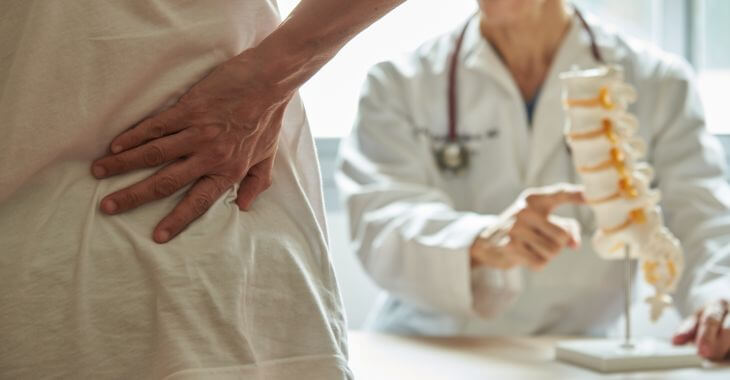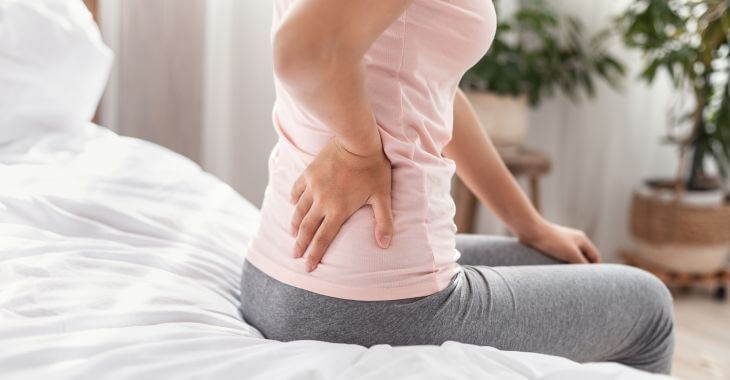What Are the Causes and Symptoms of Disc Desiccation?

The intravertebral discs in the spine are important for stabilizing and protecting the spine. These discs are cushions that provide shock absorption for the spine between the vertebrae. Each disc has a tough, fibrous outer layer and a soft, jelly-like interior. Disc desiccation occurs when the vertebral discs lose moisture, causing them to become flatter and harder, impacting the health of the spine. Here is what you need to know about disc desiccation and the causes and symptoms of this form of disc disease.
What Causes Disc Desiccation?
Disc desiccation is an integral part of degenerative disc disease. Aging, wear, tear, injury and other factors can impact the health of the vertebrae discs, causing degeneration. Degenerative disc disease is common and one of the largest factors include desiccation of the disc. The soft interior is what provides cushion and protection for the vertebrae and spine. When the disc dehydrates, it is no longer able to provide the same level of cushion for the spine. Discs that are dehydrated and brittle are also more likely to be damaged.
Aging is the most common factor in disc desiccation. As part of the normal aging process, moisture is lost in the vertebrae discs, causing them to flatten and become more brittle. The softer interior of the disc is replaced with the same tougher, fibrous tissue as the exterior. Some other contributing factors that can cause disc desiccation include:
- Rapid weight loss
- Repeated back sprains or strains
- Injuries to the spine musculoskeletal system
- Ankylosing spondylitis (AS)
Disc desiccation is common and not completely preventable. However, there are ways to slow down the progression of disc degeneration and minimize the impact on the spine and body. Staying active and maintaining a healthy weight are important. Strengthening your core can minimize strain on the spine and stretching can reduce pressure on the spinal structure. Other health factors like not smoking and drinking plenty of fluids can also be beneficial for slowing the deterioration of the spinal discs.
Symptoms of Disc Desiccation
Not everyone has symptoms from disc desiccation, especially as it occurs slowly with aging. However, when it happens quickly from sudden weight loss or injury, it is more likely to cause noticeable symptoms. Some of the possible symptoms of degenerative disc disease and desiccation include:
- Back stiffness
- Back pain
- Tingling or numbness in the back
- Weakness in the back
- Possible pain and numbness in the legs
- Changes in foot or knee reflexes
The symptoms of disc desiccation are similar to many other spine conditions, especially ones involving discs like a bulging or herniated disc, but spinal arthritis and other diseases can have many of the same symptoms. To determine whether back stiffness, pain, weakness or numbness are caused by disc disease or degeneration or many other possible spine conditions, you need a thorough exam and diagnosis from a doctor or spine specialist.
Diagnosing Disc Desiccation
Since disc disease can cause many of the same symptoms as other spine disorders, it is important to receive an accurate diagnosis. It is best to seek the advice of a spine specialist who can perform the needed tests and decipher the results to determine if you have degenerative disc disease or a different spine disorder. Tests may include x-rays, CT scan or MRI combined with a physical exam and testing reflexes or movement.
Treatment for Disc Desiccation
Conservative treatment and lifestyle changes are usually the first recommendations for disc desiccation and degenerative disc disease. Maintaining a healthy weight, regular exercise, a smoking-free lifestyle and avoiding back strain are usually recommended for mild symptoms of disc desiccation. If there is more severe pain or discomfort, physical therapy, massage therapy and over-the-counter pain medications are usually prescribed for managing symptoms.
In more severe cases of disc desiccation, more invasive treatments may be recommended. Most doctors will first try the conservative approach; but if pain, numbness, weakness and other symptoms persist, there are more aggressive treatments available. Some of the possible treatments include:
- Spinal injections to reduce inflammation and pain
- Discectomy or removal of the diseased disc
- Disc replacement
- Spinal fusion surgery
Surgery is usually the last resort when all other treatments have been explored. There are minimally-invasive spine surgery options that can reduce the risks of surgery and improve the recovery time for patients.

Disc desiccation is common with aging, but in many cases, it can be slowed or managed with certain lifestyle changes. The danger is that when discs become brittle from desiccation, they are more likely to tear or herniate, causing other problems. If you have symptoms of disc desiccation, it is important to see your doctor or a spine specialist to determine the best course of treatment. In most cases, conservative treatments can be sufficient to manage pain or discomfort, but it is possible surgery may be necessary.
The information provided on this website, including text, graphics, images, and other materials, is intended solely for informational purposes and should not be used as a substitute for professional medical advice, diagnosis, or treatment.

)